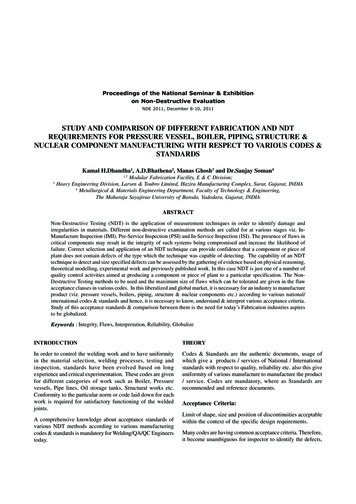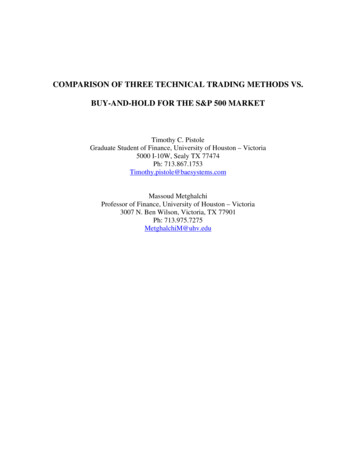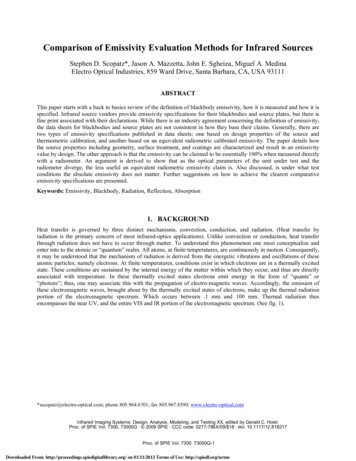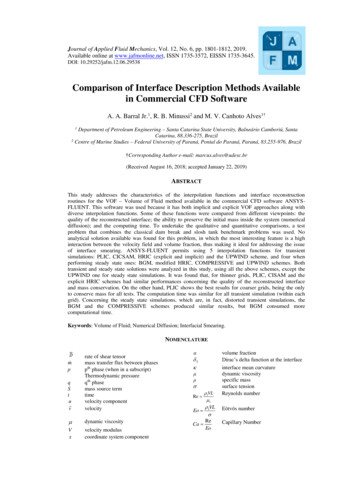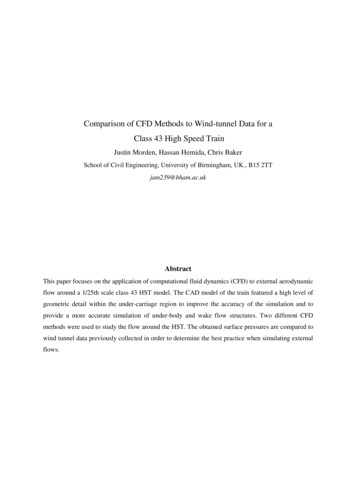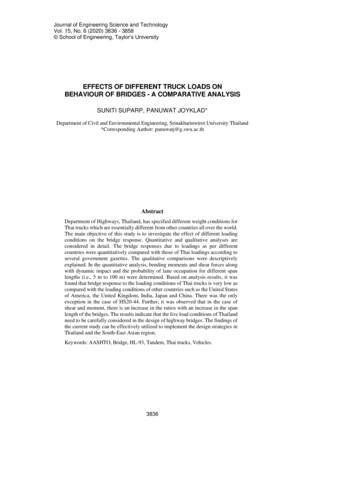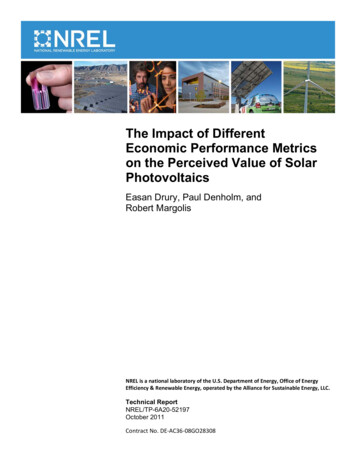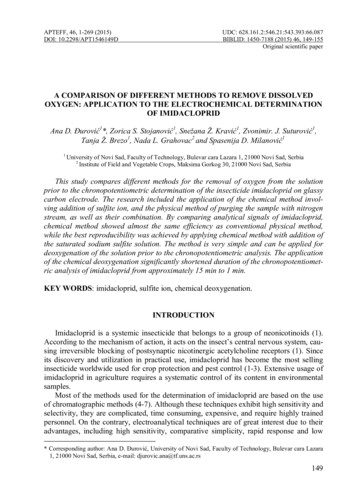
Transcription
APTEFF, 46, 1-269 (2015)DOI: 10.2298/APT1546149DUDC: 628.161.2:546.21:543.393:66.087BIBLID: 1450-7188 (2015) 46, 149-155Original scientific paperA COMPARISON OF DIFFERENT METHODS TO REMOVE DISSOLVEDOXYGEN: APPLICATION TO THE ELECTROCHEMICAL DETERMINATIONOF IMIDACLOPRIDAna D. Đurović1*, Zorica S. Stojanović1, Snežana Ž. Kravić1, Zvonimir. J. Suturović1,Tanja Ž. Brezo1, Nada L. Grahovac2 and Spasenija D. Milanović11University of Novi Sad, Faculty of Technology, Bulevar cara Lazara 1, 21000 Novi Sad, Serbia2Institute of Field and Vegetable Crops, Maksima Gorkog 30, 21000 Novi Sad, SerbiaThis study compares different methods for the removal of oxygen from the solutionprior to the chronopotentiometric determination of the insecticide imidacloprid on glassycarbon electrode. The research included the application of the chemical method involving addition of sulfite ion, and the physical method of purging the sample with nitrogenstream, as well as their combination. By comparing analytical signals of imidacloprid,chemical method showed almost the same efficiency as conventional physical method,while the best reproducibility was achieved by applying chemical method with addition ofthe saturated sodium sulfite solution. The method is very simple and can be applied fordeoxygenation of the solution prior to the chronopotentiometric analysis. The applicationof the chemical deoxygenation significantly shortened duration of the chronopotentiometric analysis of imidacloprid from approximately 15 min to 1 min.KEY WORDS: imidacloprid, sulfite ion, chemical deoxygenation.INTRODUCTIONImidacloprid is a systemic insecticide that belongs to a group of neonicotinoids (1).According to the mechanism of action, it acts on the insect’s central nervous system, causing irreversible blocking of postsynaptic nicotinergic acetylcholine receptors (1). Sinceits discovery and utilization in practical use, imidacloprid has become the most sellinginsecticide worldwide used for crop protection and pest control (1-3). Extensive usage ofimidacloprid in agriculture requires a systematic control of its content in environmentalsamples.Most of the methods used for the determination of imidacloprid are based on the useof chromatographic methods (4-7). Although these techniques exhibit high sensitivity andselectivity, they are complicated, time consuming, expensive, and require highly trainedpersonnel. On the contrary, electroanalytical techniques are of great interest due to theiradvantages, including high sensitivity, comparative simplicity, rapid response and low* Corresponding author: Ana D. Đurović, University of Novi Sad, Faculty of Technology, Bulevar cara Lazara1, 21000 Novi Sad, Serbia, e-mail: djurovic.ana@tf.uns.ac.rs149
APTEFF, 46, 1-269 (2015)DOI: 10.2298/APT1546149DUDC: 628.161.2:546.21:543.393:66.087BIBLID: 1450-7188 (2015) 46, 149-155Original scientific papercost. There are several studies about the application of electroanalytical methods for thedetermination of imidacloprid, which are based on the irreversible reduction of the analyte on the working electrode (8 - 10). This electroreduction is carried out in two steps. Inthe first step the nitro group is reduced to a hydroxylamine, and in the second step to anamine (8). Although the applied electrochemical techniques are of short duration and donot require complicated sample preparation, most of time before the analysis is spent onthe removal of dissolved oxygen from the solution, as an inevitably required step in theimidacloprid electroanalysis.The electrochemical reduction of dissolved oxygen results in high residual currentsand the production of H2O2 and OH-, which may affect the studied electrochemicalprocess in a certain potential range (11, 12). Since imidacloprid is electroactive in thesame potential range where oxygen reduction occurs, in order to avoid drawback procedures by dissolved oxygen, it has to be removed from the solution before the analysis.Therefore, many different methods are developed for deoxygenation. In general, the dissolved oxygen can be removed from solution by chemical or physical means. Amongphysical methods, purging of samples with an inert gas (usually nitrogen or argon) iscommonly used. The time required for effective removal of oxygen varies with the gasflow-rate, solution volume and geometry of the process glass, and lasts 10-15 min, thusrepresenting the most time-consuming step in the entire analysis (13). Although physicalmethods of deoxygenation are quite effective, they have a number of disadvantages. Namely, the oxygen could diffuse back into the system through tubing and joints, and it isdifficult to deoxygenate more than one sample at the same time (14, 15).Other methods for oxygen removal include the use of electrochemical or chemical(zinc) scrubbers, nitrogen-activated nebulizers, and chemical reduction (12). Chemicalreduction can be extremely effective. It is carried out by addition of a substance to thetested solution that rapidly reacts with oxygen. In the choice of a substance for chemicalreduction, it is important to avoid reaction between the reductant and the target analyte.The most common reductant reported in the literature is sulfite ion (11, 12, 16). In itsapplication it should be kept in mind that in polarography its application is limited to thesolutions of pH greater than 8, due to the appearance of polarographic waves (17). Besidesulfite ion, ascorbic acid is also used for oxygen reduction (18).This study compares different methods of deoxygenation prior to the chronopotentiometric determination of imidacloprid on glassy carbon electrode. The investigation included physical deoxygenation with nitrogen purging, chemical deoxygenation by additionof sulfite ion to the tested solution, as well as combination of physical and chemicalmethods. The objective was to simplify and shorten the procedure of oxygen removal asmuch as possible, in order to perform chronopotentiometric determination of imidacloprid by obtaining a high and reproducible signal of the analyte.EXPERIMENTALReagents and solutionsAll chemicals used were of analytical grade purity. Double distilled water was usedthroughout. Imidacloprid stock solution (0.4 g/dm3) was prepared by dissolving an appro150
APTEFF, 46, 1-269 (2015)DOI: 10.2298/APT1546149DUDC: 628.161.2:546.21:543.393:66.087BIBLID: 1450-7188 (2015) 46, 149-155Original scientific paperpriate amount of the reference standard of imidacloprid (Dr. Ehrenstorfer, Augsburg,Germany) in double distilled water. Britton-Robinson buffer, prepared from equimolar0.04 mol/dm3 stock solutions of orthophosphoric, boric and acetic acids was used as asupporting electrolyte. All three acids were purchased from Lach-Ner, Brno, Czech Republic. The appropriate pH value (7.5) of the buffer was adjusted by 0.2 mol/dm3 sodiumhydroxide solution (Lach-Ner, Brno, Czech Republic). The saturated solution of sodiumsulfite (230 g/dm3) was prepared immediately before the analysis by dissolving an appropriate amount of sodium sulfite (Centrohem, Stara Pazova, Serbia) in double distilledwater.ApparatusAll chronopotentiometric investigations were performed on a stripping analyzer withthree-electrode cell. The working electrode was a glassy carbon disk of total surface area7.07 mm2. A platinum wire (φ 0.7 mm, l 7mm) served as a counter electrode, and thereference electrode was Ag/AgCl (KCl, 3.5 mol/dm3). All values of the potential wereshown versus Ag/AgCl. Electric stick stirrer was also an integral part of the three-electrode system. The analyses were performed in special glass vessels (volume of 50 cm3)with tapered bottom. The pH values were measured with a digital pH meter model MA5705 (Iskra, Kranj, Slovenia).General procedureThe model system, consisting of the supporting electrolyte and imidacloprid was usedin all experiments. The Britton-Robinson buffer pH 7.5 was used as supporting electrolyte: 20 cm3 was pipetted into the process glass, followed by addition of a certain volumeof the imidacloprid stock solution. For the chemical removal of dissolved oxygen fromthe solution, appropriate volume (0.6, 0.8 and 1.0 cm3) of the saturated solution of sodium sulfite was added to the model system. For the physical deoxygenation, the solutionwas purged with nitrogen for appropriate time (5, 10 and 15 min), while the solution wasconstantly stirred. For removing traces of oxygen from nitrogen, the gas was first purgedthrough a pyrogallol solution, and then through the Britton-Robinson buffer, to saturategas stream in order to prevent evaporation of the sample. Nitrogen was allowed to escapethrough a tube that was immersed in the double distilled water. During nitrogen purgingthe working electrode was kept in a special glass with double distilled water. When acombination of nitrogen purging and reduction with sulfite ion was applied for oxygenremoval, 0.4 cm3 of saturated sodium sulfite solution was added to the model system, theapparatus was blanked, and the solution was purged with nitrogen for 5 min.After removing the oxygen, the solution was stirred for 15 s, followed by a quiet period (10 s), and the analysis was performed. For comparison, the deoxygenated supporting electrolyte was used as a blank. The chronopotentiogram was recorded in a potentialrange from -0.91 V to -1.42 V. All experiments were performed at room temperature(23 2oC).151
APTEFF, 46, 1-269 (2015)DOI: 10.2298/APT1546149DUDC: 628.161.2:546.21:543.393:66.087BIBLID: 1450-7188 (2015) 46, 149-155Original scientific paperRESULTS AND DISCUSSIONIn chronopotentiometry, the signal of the imidacloprid was not noticeable due to multitude of peaks that occurred on the chronopotentiogram owing to the oxygen reduction onthe working electrode. As a consequence, the final potential of the analysis of -1.42 V wasinaccessible, even by applying the maximum current of -50 μA, indicating that thedissolved oxygen had to be removed from the solution.Preliminary experiments were focused on the background chronopotentiograms recorded for the blank after applying chemical deoxygenation by adding different volumes (0.6,0.8 and 1 cm3) of saturated sodium sulfite solution. Further background chronopotentiograms were recorded for the blank deoxygenated by purging nitrogen for 5, 10 and 15 min.The experiments were performed in triplicate for each value. In the case of chemicalmethod, the addition of 0.8 cm3 of saturated sodium sulfite solution yielded the best appearance of the chronopotentiograms. Namely, the recorded chronopotentiogram was sharpwith no-signal baseline.After the addition of imidacloprid to the blank, the analytical signal appeared at thepotential of -1.2 V (9). After prolonged standing of the tested solutions in air, or aftermultiple addition of solution of imidacloprid to the process glass, only 15 s of stirring priorto the recording was enough to perform the analysis. The applied concentration of sulfiteion was enough to maintain the concentration of dissolved oxygen at a level that did notaffect the performance of the chronopotentiometric analysis.When dissolved oxygen was removed by nitrogen purging, 10 min was sufficient to thatpurpose, and a longer time did not contribute to a better appearance of the backgroundchronopotentiogram. However, further deoxygenation in duration of 2 min was requiredbecause of the oxygen creeping in from the outside. The combination of sulfite ion andnitrogen purging (0.4 cm3 of saturated sodium sulfite solution and 5 min) did not producesatisfactory result regarding the background chronopotentiograms with nitrogen purgingshorter than 10 min.In order to choose a method for oxygen removal aiming the imidacloprid chronopotentiometric determination, analytical signals of 15 mg/dm3 imidacloprid obtained afterapplying different deoxygenation procedures were considered. The results are shown inTable 1.Table 1. Analytical signals of imidacloprid in dependence of the applied method fordissolved oxygen removalDeoxygenation methodNitrogen 15 minNitrogen 10 minNitrogen 5 minNitrogen 5 min and 0.4 cm3 of saturated Na2SO3 solution0.6 cm3 of saturated Na2SO3 solution0.8 cm3 of saturated Na2SO3 solution1 cm3 of saturated Na2SO3 solution*Xmean 2SD, n 3.152Analyticalsignal (s)0.87 0.05*0.88 0.050.58 0.030.66 0.050.88 0.060.90 0.030.84 0.05RSD (%)2.872.842.593.793.411.672.98
APTEFF, 46, 1-269 (2015)DOI: 10.2298/APT1546149DUDC: 628.161.2:546.21:543.393:66.087BIBLID: 1450-7188 (2015) 46, 149-155Original scientific paperThe highest signals were obtained after the addition of sulfite ion and after 10 and 15min of nitrogen purging, and the lowest after the nitrogen purging for 5 minutes (0.58 s),while a poor reproducibility was observed by applying the combination of nitrogen purging and sulfite ion addition (RSD 3.79%). By comparing the height and appearance ofthe signals when different methods for deoxygenation were used, it can be seen that theywere practically the same. These results indicate that there was no chemical reaction between sulfite ion and the target analyte. The best reproducibility was achieved by applyingchemical deoxygenation with addition of 0.8 cm3 of saturated sodium sulfite solution(RSD 1.67%). Thanks to the much easier performance, and short duration, chemical deoxygenation with addition of 0.8 cm3 of saturated sodium sulfite solution can be acceptedas optimal in terms of the reduction of imidacloprid on glassy carbon electrode.The chronopotentiometric method using optimal deoxygenation procedure was applied for the determination of imidacloprid content in commercial formulations. Commercial formulations containing imidacloprid as an active ingredient were properly dilutedwith double distilled water, and finally with Britton-Robinson buffer. Imidacloprid wasdetermined by the calibration curve method, and the obtained results are presented inTable 2. The obtained values for the imidacloprid content were in good agreement withthe manufacturer
For removing traces of oxygen from nitrogen, the gas was first purged through a pyrogallol solution, and then through the Britton-Robinson buffer, to saturate gas stream in order to prevent evaporation of the sample. Nitrogen was allowed to escape through a tube that was immersed in the double distilled water. During nitrogen purging
